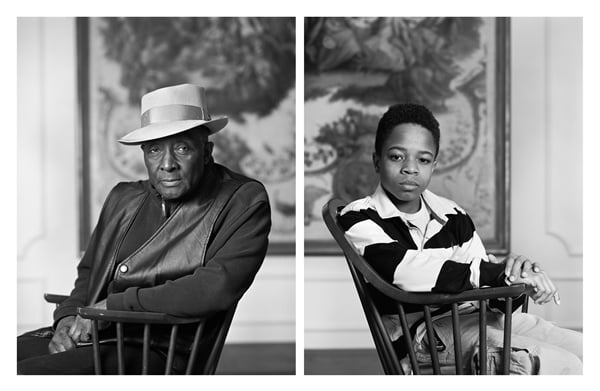Reviews
Portraits by Dawoud Bey Look American History Squarely in the Eye
A review of the artist's work on view at Mary Boone Gallery.

Photo: © Dawoud Bey, courtesy Mary Boone Gallery, New York.
A review of the artist's work on view at Mary Boone Gallery.

Christian Viveros-Fauné

High-profile controversies over racial comments by paleobigots like rancher Clive Bundy, LA Clippers owner Donald Sterling, and Wolfeboro, New Hampshire, Police Commissioner Robert Copeland have made one thing clear. The ideal of the US as a post-racial society remains just that—an unrealized ideal. As Attorney General Eric Holder reminded the country recently, ours is no time to quash difficult national conversations, but to “speak openly and candidly on the subject of race.”
Among the artists who have contributed mightily to this ongoing national discussion for more than three decades is America’s great photo portraitist: the Queens, New York–born, Chicago-based Dawoud Bey. The 60 year-old has spent a lifetime portraying fellow citizéens with an eye peeled to their telltale social circumstances. Currently, Bey has several terrific works at the Whitney Biennial 2014. Among them is a 2008 photo of a confident candidate Barack Obama, as well as several diptychs from his landmark 2012 series “The Birmingham Project.” The latter—the product of a lifetime of consideration and more than seven years of research—is currently on view as a more complete series at Mary Boone’s uptown gallery at Fifth Avenue and 57th Street.
One might say Bey began “The Birmingham Project” almost 50 years ago—when he was just 11 years old. A response to an image young Bey saw of the aftermath of the Ku Klux Klan bombing of the 16th Street Baptist Church in Birmingham, Alabama, in 1963, the work began taking shape after that epochal photograph from Lorraine Hansberry’s book The Movement: Documentary of a Struggle for Equality was tattooed onto the artist’s brain. What the preteen Bey encountered 49 years ago was a black-and-white reproduction of a 12 year-old girl named Sarah Jean Collins—lying on a hospital bed, her face mangled. The image gripped the young Bey like a virus. As an African-American child, he intuitively understood that it could have been him lying there instead.
Four other little girls died in that infamous bombing, one of them 11 and the other three 14; additionally, two boys, ages 13 and 16, were shot and killed in related assaults by latter-day George Zimmermans. Fast-forward nearly half a century and the horror of such crimes perpetrated against innocent children remains with us, even if it has shed its cartoonish Bull Connor twang. As Bey told one interviewer, the memory of that photograph eventually compelled him to “come to terms with that moment in some way, by making work about it.” As the 50th anniversary of the murders approached, an invitation from the Birmingham Museum of Art provided the perfect catalyst. The results are flesh-and-blood re-imaginings of history told in black and white—photography’s version of buffed and chiseled granite.
Made up of large-scale photographic portraits as well as a 15-minute accompanying video, Bey’s images were shot over a period of five months at two locations in Birmingham: the museum and the Bethel Baptist Church, the site of earlier white supremacist violence. The artist’s subjects are children of the same age as the 1963 victims, and adults 50years older—the very age the innocents would be had they somehow survived the tragedy. Seated in chairs or church pews, composed symmetrically, and facing the camera directly, Bey has arranged his portraits into diptychs. The images are, at once, poignant, poetic and plainspoken. Conflations of time past and time present, the artist’s photographs record 26 of history’s living subjects while proposing a future that looks dangerous Charles Murray–type revisionism squarely in the eye.
Among Bey’s diptychs, several stand out for the sharp commonalities and contrasts he purposefully elicited from the sitters’ attitudes and clothing (the artist selected subjects partly to underscore these visible relationships). One set of images features a girl with a curly fringe and a screwed up mouth paired with an older counterpart whose enlightened dreads sympathetically match her pained eyes. Another male duo does more than simply point up the expected gulf between youth and experience. A mismatch between the sartorial innocence of a wide-striped rugby shirt and a world weary fedora, these two strangers reveal an intimacy that grows as the viewer considers the tricky passage of African-American manhood—there’s the well-trod span between youthful cockiness, on the one hand, and confidence, suspicion, and fatigue, on the other.
Bey’s split-screen video, “9.15.63,” humanizes the artist’s story even further. An interior and exterior view of Birmingham on a sleepy Sunday morning, the artist juxtaposes footage of a darkened diner and a barbershop with the tops of trees, the gables of single-family houses, and blue sky. As the video concludes with images of children’s drawings and the storefront sign for the 16th Street Baptist Church, the viewer realizes he’s retraced the children’s steps that fateful morning. There’s a revelation in those moving images. Putting yourself in another person’s shoes, Bey seems to say, is not just an act of sympathy—it’s also a bit of history-making.
“The Birmingham Project” is on view at Mary Boone Gallery through June 28.